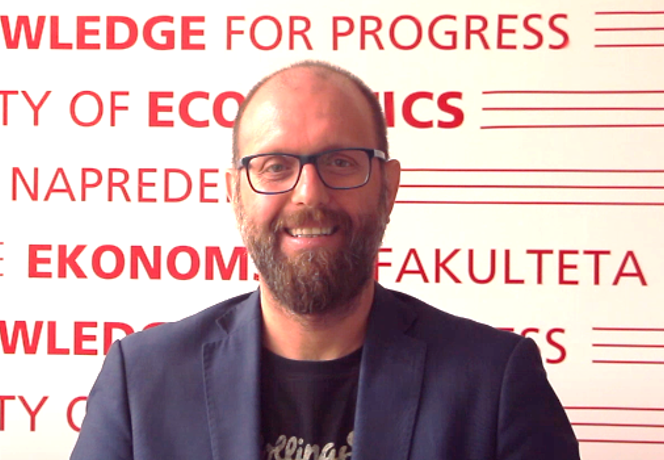
“With neuro leadership we do not look at people as who they think they are or as consciously controlled individuals, but as how their brains react.” – Nikolaos Dimitriadis
What do you have in mind when speaking about modern leadership?
Modern leadership has to follow a modern organization, so for me modern leaders are the ones that manage to break away from the mental barriers of the old management and organizational systems. The way that scientific management was first developed by Frederic Taylor and other people and the beginning of the industrial revolution had a very specific task – to optimize performance with specific benchmarks. But when you want people to be innovate, to go outside of their comfort zone, and create new disruptive moves, then the old way is not good enough and it becomes an obstacle rather than a booster. A modern leader is the one that can both, recognize when to apply the old model for stability and management, so our corporate system survives, but also when to use innovation as we approach the customers with a religious focus on their delights, satisfaction, and loyalty. We have to be a leader that we want the others to follow, we have to walk the talk – and these are the new leaders, who move effortlessly through new models and slowly get away from the management and organizational systems of the past. Old management was about getting things done. Therefore, if you got your thing done you performed well as a manager and for that reason we confuse this with great leadership. Great and modern leaders do not just get things done, they get the right things done fantastically well, through their best people who are performing at their highest level. And exactly that is the difference between new management and new leadership.
FELU MBA just introduced neuro leadership into the program. What will neuro science add to the FELU MBA participants?
The FELU MBA is extremely innovative in applying neuro science research to its executive FELU MBA students. Only a few MBA programs around the world are as cutting edge as this one. We now know that the self-reporting part of the brain, which talks about experience, interacts with other people through words and believes that it is a person’s consciousness that controls behavior, is not the one that runs the show. Behavior is driven by different parts of the brain working together for the final outcome. Neuro leadership is modern approach on looking at personal and group behavior, which utilizes latest research insights from neuroscience evolutionary, biology, anthropology, psychology, and other sciences. With neuro leadership we do not look at people as who they think they are or as consciously controlled individuals, but as how their brains react. Practically, with applied neuro research we are trying to discover how different parts of the brain respond to stimulators. Based on these results we can have a very interesting picture of leadership and related capabilities such as empathy, resilience and growth mindset. Based on the research of MBA students while they are sitting and watching these stimulators on a screen, we can have an individual score of how they perform in these leadership skills. Our goal is to familiarize managers with neuro science and help them understand their brains in a deeper and more holistic way, so that they can become better leaders.

Better leaders. What does that even mean?
The old mindset was that leaders work with the processes and employees inside the company and only managers deal with the customers. But today the best CEOs are marketing oriented CEOs, for example Steve Jobs, Jeff Bezos and Elon Musk. None of them is an internal CEO, they all are in a direct interaction with the real world. Therefore, their goal is to solve real problems in a real world in a real way, which is what great leaders do today. They understand the current and future state of society and how their company is going to feed it and respectively change it. I have seen extreme leaders, that are always outside of the company and also those who are always in the company – both situations are negative. There must be an interplay between being outside and being inside, which has a lot to do with one’s state of the company, periods of time, industry etc. But it is imperative for a leader and the team around him to spend time outside the company, to be fully engaged with the real world, the competition, the industry, finances, consumer trends, distributors, technology, etc. They cannot sit inside their office all day and read an article on LinkedIn. Because the brain will get much more signals and get much more information and sub-conscious intuition outside the four walls of the organization, which you have to infuse into the company. Being within four walls all day cannot lead us to the information of what the customer and the supplier wants – a pie chart does not engage the brain, so there can be no creativity and solutions due to the lack of motivation.
So, be real, be outside but also stay inside, you have to be active and dynamic, create a team that understands the importance of the company within the society and the market that it lives in. Unfortunately, the old managerial system creates a big gap between the outside and the inside, and it is on modern leaders to break this barrier.
Why has neuroscience become a hot topic and why is it important to understand how does a consumer behave nowadays?
Neuro marketing is nothing new, it has existed for 20 years and has become mainstream globally. Most companies have not heard of it or have not implemented it, which is why we created a cutting-edge science lab in south-east Europe to do work all around the world. What is interesting to me are the surprises we see every day with neuro HR, which is testing the brains of people before employing them or promoting them. But this is a very fresh topic and there are very few neuroscience labs, but we are happy to collaborate with FELU MBA.
Concerning neuro marketing there are some very interesting results that are repeating themselves as we do research around the world, I will mention just two.
The first one is the different response of the millennial brain compared to older generations when it sees stimulators. There is a lot of talk about the millennial concept and some people are attacking it. Traditional marketing techniques fail to generate strong focus to the millennials’ visual attention. To say it more simple, on the one hand millennials seem to have this wandering gaze pattern, rather than focusing on specific elements of packaging, POS materials or advertising. On the other hand, older generations seem to be able to find points that the brain finds interesting within milliseconds. The millennial brain is just wandering around without creating these strong points. Due to their different upbringing and the fact that they are digital natives, their brain requires a different and stronger motivation for them to focus on something. Therefore, when you approach millennial there can be no mediocracy, you have to be bald, strong and very emotional, which is risky, as you will either make it or not, but you cannot be in the middle.
The second interesting thing is the difference in engagement. We measure it through an electro encephalogram, an x-ray of consumer’s brain measuring brain activity. The engagement between males and females is substantially different. There are different products and retail environments where there is a huge difference between them. On average the female brain is more engaged than the male brain in most of the situations. Even in financial institutions the research showed that the male brain was less engaged and working on auto-pilot or was in a zombie mode. What we recommend our clients is that there are some stereotypes, some overall results, but they have to be careful with this, they have to do the study every time for their specific product in a specific situation to see how it attracts the eyes, emotions, and the brain of their customer base.
Why is status quo no longer acceptable and how can you make a change?
Today’s business environment is characterized by increasingly high levels of uncertainty and change. As both, environment and consequently organizations are changing, executives and managers need to prepare themselves to adapt successfully to a rapidly changing business environment. Flexibility and a willingness to embrace change will make you a more valuable member of your organization. You will become someone who can reliably deal with many different opportunities and circumstances. Of course, no one is saying that you will like all the changes that are occurring, but you can be sure that if you resist them, you will not prosper. And how can you make a change? With not giving up and standing up even if we fall multiple times. Everything is about continuous practice and obtaining the right knowledge. I think that nobody should be afraid or worried of changing their fundamental view of what makes us human. We need this change fast – great leaders have done it already, actually they do it every day. We need to change it fast, as we have to abolish the perceptions of the importance, control, and self-arrogance that our conscious mind adapts and then connects with people. But most importantly we have to make a change with ourselves, otherwise we will continue to get disappointing results. Once you recognize the possibilities created by change, you are also more prepared to exploit them. You will find change as not something to fear, but as something to welcome and turn to your own advantage.
Nikolaos Dimitriadis is one of the guest lecturers at LJUBLJANA MBA programme. Besides that we will host him at the following events: